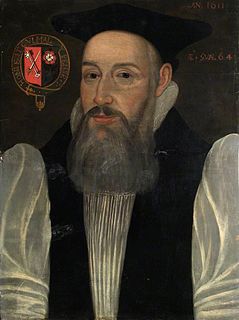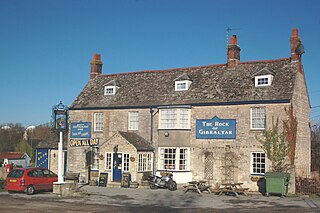Related Research Articles

Kett's Rebellion was a revolt in Norfolk, England during the reign of Edward VI, largely in response to the enclosure of land. It began at Wymondham on 8 July 1549 with a group of rebels destroying fences that had been put up by wealthy landowners. One of their targets was yeoman Robert Kett who, instead of resisting the rebels, agreed to their demands and offered to lead them. Kett and his forces, joined by recruits from Norwich and the surrounding countryside and numbering some 16,000, set up camp on Mousehold Heath to the north-east of the city on 12 July. The rebels stormed Norwich on 29 July and took the city. On 1 August the rebels defeated a Royal Army led by the Marquess of Northampton who had been sent by the government to suppress the uprising. Kett's rebellion ended on 27 August when the rebels were defeated by an army under the leadership of the Earl of Warwick at the Battle of Dussindale. Kett was captured, held in the Tower of London, tried for treason, and hanged from the walls of Norwich Castle on 7 December 1549.

WatTyler was a leader of the 1381 Peasants' Revolt in England. He led a group of rebels from Canterbury to London to oppose the institution of a poll tax and to demand economic and social reforms. While the brief rebellion enjoyed early success, Tyler was killed by officers loyal to King Richard II during negotiations at Smithfield, London.
The Prayer Book Rebellion or Western Rising was a popular revolt in Cornwall and Devon in 1549. In that year, the Book of Common Prayer, presenting the theology of the English Reformation, was introduced. The change was widely unpopular, particularly in areas where firm Catholic religious loyalty still existed, such as Lancashire. Along with poor economic conditions, the enforcement of the English language literature led to an explosion of anger in Cornwall and Devon, initiating an uprising. In response, Edward Seymour, 1st Duke of Somerset sent Lord John Russell to suppress the revolt, with the rebels being defeated and its leaders executed two months after the beginning of hostilities.

Eynsham is an English village and civil parish in Oxfordshire, about 5 miles (8 km) north-west of Oxford and east of Witney. The 2011 Census recorded a parish population of 4,648. It was estimated at 5,077 in 2018.

Simon Forman was an Elizabethan astrologer, occultist and herbalist active in London during the reigns of Queen Elizabeth I and James I of England. His reputation, however, was severely tarnished after his death when he was implicated in the plot to kill Sir Thomas Overbury. Astrologers continued to revere him, while writers from Ben Jonson to Nathaniel Hawthorne came to characterize him as either a fool or an evil magician in league with the Devil.
Sir Christopher Blount was an English soldier, secret agent, and rebel. He served as a leading household officer of Robert Dudley, 1st Earl of Leicester. A Catholic, Blount corresponded with Mary, Queen of Scots's Paris agent, Thomas Morgan, probably as a double agent. After the Earl of Leicester's death he married the Dowager Countess, Lettice Knollys, mother of Robert Devereux, 2nd Earl of Essex. Blount became a comrade-in-arms and confidant of the Earl of Essex and was a leading participant in the latter's rebellion in February 1601. About five weeks later he was beheaded on Tower Hill for high treason.

Hampton Poyle is a village in the Cherwell valley in Oxfordshire, England, about 1 mile (1.6 km) northeast of Kidlington and about 5 miles (8 km) north of the centre of Oxford. It is part of the civil parish of Hampton Gay and Poyle. Hampton Poyle was a separate civil parish of 807 acres (327 ha) until 1932, when it was merged with the neighbouring parish of Hampton Gay.

The Vagabonds Act 1597 was an Act of the Parliament of England.

Marcus Gheeraerts was a Flemish artist working at the Tudor court, described as "the most important artist of quality to work in England in large-scale between Eworth and van Dyck" He was brought to England as a child by his father Marcus Gheeraerts the Elder, also a painter. He became a fashionable portraitist in the last decade of the reign of Elizabeth I under the patronage of her champion and pageant-master Sir Henry Lee. He introduced a new aesthetic in English court painting that captured the essence of a sitter through close observation. He became a favorite portraitist of James I's queen Anne of Denmark, but fell out of fashion in the late 1610s.
Thomas Bradley was born in 1596 or 1597, the son of Henry Bradley of Wokingham in Berkshire and his wife, Barbara daughter of Walter Lane of Reading in the same county. He was educated at Exeter College, Oxford and was admitted to the degree of Doctor of Divinity. On 5 March 1631, he married Frances the youngest daughter of John, Baron Savile of Pontefract.

Thomas Bilson was an Anglican Bishop of Worcester and Bishop of Winchester. With Miles Smith, he oversaw the final edit and printing of the King James Bible.
Sir John Townshend MP, of Raynham Hall in Norfolk, was an English nobleman, politician, and knight. He was the son of Sir Roger Townshend and Jane Stanhope. He was also a soldier and Member of Parliament. He was killed in a duel with Sir Matthew Browne in August 1603.

Enslow is a hamlet on the banks of both the River Cherwell and the Oxford Canal in Bletchingdon civil parish, Oxfordshire. The medieval main road linking London with Chipping Norton and Worcester crosses the Cherwell at Enslow. There was a bridge here by the time that John Leland toured England in 1538–43. John Ogilby's Britannia Atlas of 1675 records a timber bridge here that he called "Emley Bridg". In 1718 the road was made into a turnpike and at some stage the timber bridge was replaced by one with pointed stone arches. In 1814 the stone bridge was widened on its downstream side. to almost double its former width. In contrast with the older upstream side of the bridge, the 1814 arches are semicircular. The road is now the A4095.

Hethe is a village and civil parish about 4.5 miles (7.2 km) north of Bicester in Oxfordshire, England.

Great Haseley is a village and civil parish in South Oxfordshire, England. The village is about 4.5 miles (7 km) southwest of Thame. The parish includes the hamlets of Latchford, Little Haseley and North Weston and the house, chapel and park of Rycote. The parish stretches 6 miles (10 km) along a northeast — southwest axis, bounded by the River Thame in the north, Haseley Brook in the south and partly by a boundary hedge with Little Milton parish in the west. The 2011 Census recorded a parish population of 511.

Hampton Gay is a village in the Cherwell Valley about 1.5 miles (2.4 km) north of Kidlington, Oxfordshire.
The Oxfordshire rising took place in November 1596 under the rule of Queen Elizabeth I of England during times of bad harvest and unprecedented poverty. A small group of impoverished men developed a plan to seize weapons and armour and march on London, hoping to attract "200 or 300... from various towns of that shire". They met on Enslow Hill on 21 November, but without any of the assumed support were quickly arrested, and tortured due to suspicions of a wider conspiracy. A year later two of the men were hanged, drawn, and quartered for their treason.

Sir Anthony Hungerford (1567–1627) of Black Bourton in Oxfordshire, Deputy Lieutenant of Wiltshire until 1624, was a member of parliament and a religious controversialist.
The Buckinghamshire and Oxfordshire Rising of 1549 was a rural rebellion that took place in Tudor England under the rule of Edward VI's Lord Protector, Edward Seymour, 1st Duke of Somerset. Part of a series of disturbances across the country, it took place at the same time as the better-known Prayer Book Rebellion or Western Rising and for many of the same reasons: discontent at the introduction in June 1549 of the Book of Common Prayer, fuelled by economic distress and resentment at enclosures of common land. Kett's Rebellion, which centred on enclosures, took place in the same month, contributing to a growing sense of national disorder in what was popularly known afterwards as "the commotion time".

The 2nd Spanish Armada also known as the Spanish Armada of 1596 was a naval operation that took place during the Anglo–Spanish War. Another invasion of England or Ireland was attempted in the autumn of 1596 by King Philip II of Spain. In an attempt at revenge for the English sack of Cadiz in 1596, Philip immediately ordered a counter strike in the hope of assisting the Irish rebels in rebellion against the English crown. The strategy was to open a new front in the war, forcing English troops away from France and the Netherlands, where they were also fighting.
References
- ↑ Lobel 1959, pp. 152–159.